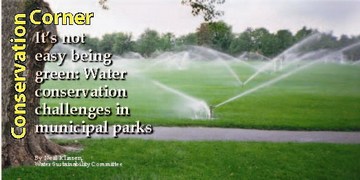Conservation Corner: It’s not easy being green – Water conservation challenges in municipal parks

In my Summer 2007 column I wrote about water use in BC’s municipal parks. The information came from surveys I conducted for a Masters thesis, including interviews with municipal parks’ managers in British Columbia. For this issue I would like to write about the seven major themes that emerged from those interviews:
- There are mixed opinions about the need for water conservation in BC. While many managers indicated that water conservation is important in their community, several believe that it is not an issue at all. Surprisingly, the biggest opinion split is in the lower mainland communities that receive
water from the GVRD. - Water usage for parks irrigation is largely unmeasured and under-priced. Most new parks have meters installed as they come online, but water use is not measured in thousands of existing parks across the province. In most
cases, the parks department pays a flat rate for water that is nowhere near the actual cost of service. - Few parks departments have a water conservation plan. Parks departments are all concerned about water efficiency, and most of them work hard to avoid water waste. However, few parks departments have an actual, formalized water conservation plan with specific reduction targets, with the notable exceptions of Penticton and Surrey.
- Technology provides both opportunities and challenges for water conservation. Centrally-controlled irrigation systems can reduce water consumption up to 25 per cent, as experienced by the City of Kamloops. However, without regular monitoring and maintenance, deficiencies in systems often go unnoticed resulting in higher water use than is usually necessary to keep a park green.
- Sports fields are exempt from water restrictions. Sports fields are sandbased; two days without water can burn out a field. No parks department wants to lose that investment, so the fields are watered frequently. It is necessary, but it also creates a perception problem when the public sees a parks department breaking water restrictions.
- Parks are not designed with water conservation in mind. Most parks,
especially in the dry southern interior, were built when no one had water
conservation in mind. These parks set the standard and with few exceptions
parks are still being built that way. - Public expectations have a major impact on parks design and irrigation practices. Community parks in Victoria and Surrey might go brown in summer, but for the rest of the province the public expects green, and lots of it. In some communities, parks telephone lines light up like a Christmas tree if there is a brown spot in a park. For a parks department, water conservation and pleasing the public can be competing priorities, with
conservation usually coming out the loser.
The American Water Works Association defines water conservation as “activities designed to 1) reduce the demand for water, 2) improve efficiency in use and reduce losses and waste of water, and 3) improve land management practices to conserve water”.
While all the parks departments survey actively to improve watering efficiency, only a select few are investigating ways to significantly reduce demand for water or implementing land management practices to conserve water. To be fair, the second and third points may not even be a parks department role. Water providers, city planners and elected officials all need to collaborate if they believe water conservation is important.
For the record, it is not my intention to point fingers at parks departments and say that they are not doing their jobs. Based on my interviews and the discussions with the parks managers and staff I know personally, I want to commend them for doing the best they can given limited budgets, staff and conflicting priorities. However, when it comes to a municipal park, it is not easy being green.
By Neal Klassen, BCWWA “Watermark” contributor
Posted June 2008
Originally published in the Fall 2007 issue of Watermark Magazine, the official publication of the British Columbia Water & Waste Association (BCWWA).

